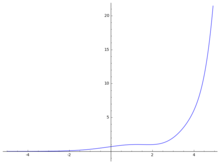Hadamard's gamma function
In mathematics, Hadamard's gamma function, named after Jacques Hadamard, is an extension of the factorial function, different from the classical gamma function. This function, with its argument shifted down by 1, interpolates the factorial and extends it to real and complex numbers in a different way than Euler's gamma function. It is defined as:

where Γ(x) denotes the classical gamma function. If n is a positive integer, then:
Properties
Unlike the classical gamma function, Hadamard's gamma function H(x) is an entire function, i.e. it has no poles in its domain. It satisfies the functional equation
with the understanding that is taken to be 0 for positive integer values of x.
Representations
Hadamard's gamma can also be expressed as
and as
where ψ(x) denotes the digamma function.
References
- Hadamard, M. J. (1894), Sur L’Expression Du Produit 1·2·3· · · · ·(n−1) Par Une Fonction Entière (PDF) (in French), Œuvres de Jacques Hadamard, Centre National de la Recherche Scientifiques, Paris, 1968
- Srivastava, H. M.; Junesang, Choi (2012). Zeta and Q-Zeta Functions and Associated Series and Integrals. Elsevier insights. p. 124. ISBN 0123852188.
- "Introduction to the Gamma Function". The Wolfram Functions Site. Wolfram Research, Inc. Retrieved 27 February 2016.